Straddle up, we're in for a bumpy ride through the wild west - one of the most exciting times to be alive in all of history. It was a time of unbridled possibility, with all kinds of opportunities presenting themselves.
Many a journeyman moved to the new American frontier seeking a better life, with some ending up on the wrong side of the law to make themselves a living. Life sure was an adventure for these folks!
The Famous Leavitt Saloon
Bob’s Saloon was a popular establishment in the early 1900s for the inhabitants of Jordan, Montana. This 1904 photo by L.A. Huffman shows a group of cowboys relaxing in front of the old saloon. Robert Leavitt, the saloon's owner, happened to be a cowboy himself and was among the first residents to settle in Jordan.


The old west saloons offered patrons all types of entertainment such as dancing girls, card games, dice games, and even bowling. Many saloons employed piano players and put on theatrical skits to entertain customers.
Buffalo Bill’s Wild West Show
Buffalo Bill's Wild West Shows were a traveling troupe of performers who helped romanticize life in the American Frontier. The show included a variety of acts, including a parade, the reenactment of the incident at Warbonnet Creek, and many other acts similar to that of a circus.


Are you not entertained? Buffalo Bill is known as one of the most influential showmen of all time. His wild reputation spread through the old west like wildfire. Bill was both a scout and a bison hunter, but his real love was working his show to enthralling crowds. Pictured sitting above is Buffalo Bill himself.
Buckle up and keep on reading to learn more:
Two Cowboys Walk Into A Bar
In 1822 the first-ever saloon, Brown's Hole, was established in Wyoming, however, the idea quickly caught on and before you knew it saloons were popping up all around the new American frontier. Saloons were classified as a specific kind of bar that served a wide assortment of people, including cowboys, soldiers, miners, fur trappers, and many more in the old west.
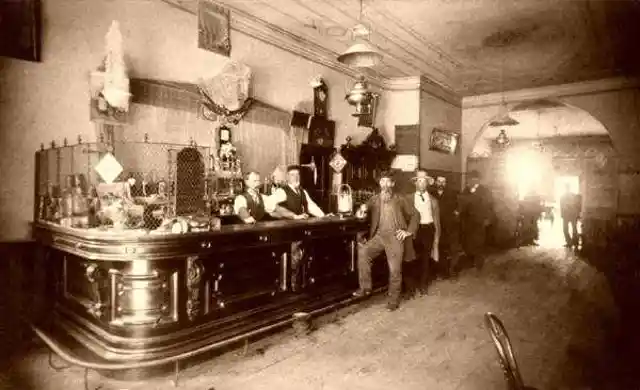

By 1880, saloons had become one of the most popular establishments available. Bartenders took great interest in their saloon's appearance and also worked on their drink pouring abilities. Not by coincidence, many of these same saloons were used for gambling, prostitution and opium dens. Cowboys wet more than their whistles at these premises it seems.
Charging Thunder
Lakota chief Charging Thunder was one of the several Native Americans who participated in Buffalo Bill’s Wild West Show. He joined the crew at 26 years old and eventually married one of the American horse trainers in the crew… ah, talk about stage romance!


After finishing up at Buffalo Bill’s show, Charging Thunder worked at Manchester’s Belle Vue Circus as an elephant trainer. He also became a British citizen around this time. Charging Thunder later changed his awesome name to boring one, calling himself George Edward Williams. He eventually found a factory job after his circus gig.
The Mojave Native American Interpreter
Pictured above is Maiman, a Mojave Native American. Maiman worked as a guide and interpreter in Colorado, particularly during the 1870s. Maiman guided renown photographer Timothy O’Sullivan around, helping him find the best locations for his enduring photographs.


O’Sullivan, unlike many other photographers at the time, didn’t like to photograph Native Americans in a studio. As such, his works reflected a realistic quality such as in this photo. O'Sullivan also famously photographed many Civil War battlefields after his time in the war.
Outlaw: Billy The Kid (1879)
Billy the Kid, birthname Henry McCarty, was one of the most well-known outlaws of the old west. McCarty was one of the most notorious gunfighters of his time, having killed at least 8 men at a very young age.


He was born in New York City but later lived mainly in New Mexico. At one time he even fought in New Mexico's Lincoln County War. McCarty was eventually arrested and jailed. He died while attempting to escape his jail cell when Sheriff Pat Garrett fired a gunshot hitting him in the chest.
McCarty was just 21 years old when he died. However, his legacy didn’t end there. It was rumored that the outlaw didn’t die in the prison gunfight and over the next few decades several people committed crimes while claiming to be Billy the Kid.
General Custer Crossing Dakota During The Civil War
This iconic photograph features General Armstrong Custer’s men crossing the plains of the Dakota Territory as it was known then. The area encompassed present-day North and South Dakota. General Custer was an officer in the United States Army during the American Civil War and the American Indian Wars.


This photo was taken by Englishman W.H. Illingworth. Traversing the Black Hills of the Dakotas, Illingworth once joined an expedition to the Montana Territory in the 1860s and 1870s.
A Soiled Dove
It might come as a surprise but many notorious madams and prostitutes were actually considered fixtures of old west towns. Some were so popular and successful they became millionaires! Some traveled from all over the world despite the harsh conditions they had to endure in those times.


These scarlet-clad women had different, surprisingly poetic nicknames, depending on the region. In California, they were labeled “soiled doves” by the cowboys, and “sporting women” or “ladies of the line” by California's 49er. Other nicknames were “doves of the roost”, “fallen frails”, “nymphs du prairie”, and even “fallen angels”.
Navajo Native Americans Near Fort Defiance
Photographer, Timothy O’Sullivan, captured this moment and printed it in 1873, labeling it “Aboriginal Life Among the Navajo Native Americans Near Old Fort Defiance, New Mexico”. The scene shows the Navajo at their residence, which in this instance was an abandoned military post.


The Navajo are one of the most wealthy aboriginal tribes of the United States and were known for being very intelligent and fierce. In this photo, you can see the ears of corn they cultivated, and the looms they used for making blankets.
The Wheeler Survey Group
This happy looking bunch were the Wheeler Survey group. Led by Captain George Montague Wheeler, the Wheeler Survey was a giant expedition to survey the Western United States. The expedition began in 1869 and ended in 1879. The group's extensive work led to the creation of topographic maps of the Southwest.


Captain Wheeler had three areas named after him: Wheeler Peak in Nevada, Wheeler Geologic Area in Colorado, and Wheeler Peak in New Mexico! All in a decade's work.
Doc Holliday, All Around Man
Doc Holliday was a professional gambler, gunfighter, and... dentist! He came to be known mostly for his skilled gunfighting ability. He was a good friend of Wyatt Earp and rode out with him when they avenged the murder of Wyatt's brother, Morgan.


Holliday first became a dentist when he was 20 years old. Unfortunately, he was soon diagnosed with tuberculosis, pushing him to become a gambler in Arizona. He featured in several famous gunfights throughout his life, most of which were alongside his good friend, Wyatt Earp.
Wyatt Earp (1887)
Wyatt Earp and Doc Holliday were good friends who shared similar interests. Two of these interests were their love for gunslinging and gambling. Earp was a proficient gambler in the Wild West, but he also held a steady job as a deputy sheriff in Arizona. Talk about living on the edge of the law.
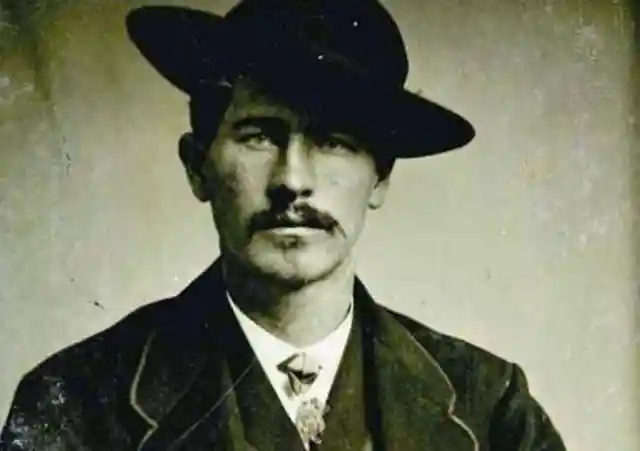

Earp gained notoriety when he killed three cowboys at the O.K. Corral in a gunfight. From that moment on, he was regarded as a shooter, particularly in Tombstone, Arizona. He held various jobs through his life such as a lawman, buffalo hunter, saloon keeper, miner, boxing referee, gambler, and brothel keeper. Earp frequently clashed with cowboys until his death in 1929.
Morgan Earp, Deputy Marshal
Brother of Wyatt Earp, and friend of Doc Holliday, Morgan Earp was just like his brother. Morgan also had a love for confronting outlaw cowboys in Tombstone, Arizona. The Earp brothers intruded so much that they eventually all had targets on their heads.


Poor Morgan eventually fell victim to an ambush where he was shot and killed through a window while playing billiards. Like any good elder brother, Wyatt Earp took matters into his own hands after the courts failed to punish those responsible. He successfully heaped revenge on the perpetrators - outside the law of course. One thing's for sure, the wild west was never dull!
Louisa Earp, Morgan Earp’s Wife
Morgan Earp was married to Louisa Earp, the daughter of H. Samuel Houston and Elizabeth Waughtal, though nobody knows how they met or got married. The couple lived in Montana at first before moving to California.

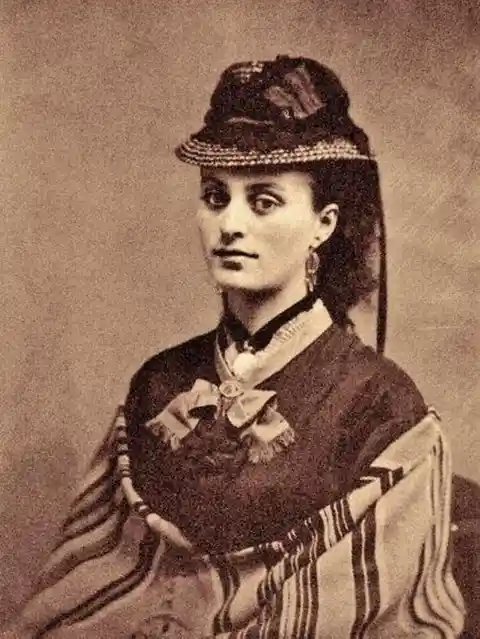
When Morgan moved to Arizona, he left Louisa behind in Colton with his parents. Expecting it to be a short trip, the two would never meet again as Morgan was assassinated. Louisa eventually married again on New Year’s Eve in 1885 to Henry Gustav Peters. However, the marriage does not appear to be a happy one. I guess, Morgan was a tough act to follow!
Old Mission Church, New Mexico
The Old Mission Church in Zuni Pueblo in New Mexico was established back in 1630 and is one of the earliest examples of a Spanish Colonial era mission. Although relatively small, the church is quite complex.


During the Pueblo Revolt, the Mission played an important part and was inhabited by Franciscans for some time until Mexico gained independence from Spain. Today it features as a tourist attraction for Zuni Pueblo as a long-standing piece of adobe history.
Sioux Native American Teepees
The Sioux Nation of Native Americans was one of the largest tribes to have lived on the Great Plains. The Sioux Nation comprised of three tribes: Eastern Dakota, Western Dakota, and the Lakota tribes. All three were nomadic tribes and hunted bison. The Sioux built teepees to establish their life on the great plains as can be seen in this photo.


The date of this photo isn't known, but the area is estimated to be somewhere in the Territory of Dakota.
Sterling, Goldie Griffith’s Son
Goldie Griffith was a Wild West show icon who married fellow Buffalo Bill performer, Harry Griffith at Madison Square Garden on May 9, 1913. Even if the couple's marriage was shortlived it did produce an adorable baby boy named Sterling, pictured above.


Subsequent to her performing career, Goldie Griffith moved with her son to Nederland, Colorado. Here, it is said she raised him alone in a happy tight-knit family. The family opened a number of restaurants and also trained dogs in their new city.
Timothy O’Sullivan Native American Photograph
Born on Staten Island in New York, Timothy O'Sullivan was one of the most influential photographers of the American Civil War. He also made a reputation for his photography of the American Western Landscape. One of his most well-known photos is of a group of Native Americans, pictured above.


O'Sullivan teamed up with a geological survey team in 1871. This allowed him to venture around the United States taking pictures, particularly of the pueblos of the Canyon de Chelly.
Giddy Up Cowboy
The term cowboy originated from the Spanish word "Vaquero", meaning a livestock herder riding on horseback, which required both skill and plenty of physical ability, developed from a young age. Therefore, cowboys were much more than simple animal herders.


Although cowboys in America were predominantly Caucasian men, quite a few African American free-men and Mexicans and Native Americans were working as cowboys by the late 1860s. The classic iconic cowboy look included a bandanna, a pair of jeans, chaps, leather gloves, boots, and most importantly a wide-brimmed cowboy hat.
Mine Your Own Business
Many towns revolved around and relied solely on mining and as such, mining was the bedrock of the Wild West with jobs-a-plenty. In this photo is a silver mine in Virginia City, Nevada. The city had two major mines: Savage, and Gould and Curry.


Can you believe the miner in this photo is 900 feet underground? Remarkably, he's able to use burning magnesium wire for light. Following the discovery of silver deposits, Virginia City soon became a boomtown. At its peak, the city boasted over 25,000 residents. When the mine’s output began declining, so did its residents. As of 2010, only about 850 people live in Virginia City.
Washing Up In The Wild West
Pictured in this photo is a man enjoying a bath in Pagosa Hot Springs in Colorado. The hot springs still exist even today. How amazing it is we can still enjoy the same simple things as those in the American 19th century.

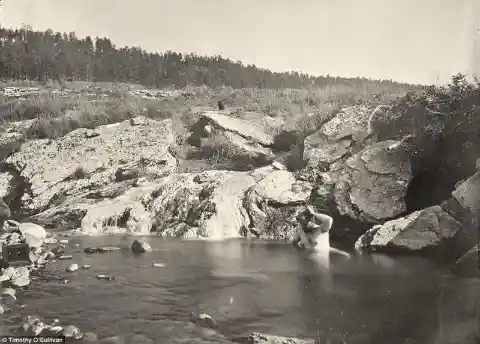
In those times, people used to believe the rich mineral waters of Pagosa Hot Springs would cure any ailment and also rejuvenate a person. This guy clearly seems to be enjoying himself.
Buffalo Soldier, 1890
A face without a name. Unknown to anyone by name, this horseman's face is now etched in history. Buffalo Soldiers was the name given to the 10th Cavalry of the United States Army between 1866 and 1951.


The nickname, Buffalo soldier, however, was given to African-American soldiers by local Native Americans when the soldiers fought during wartime. The name has stuck ever since, we're looking at you Bob Marley!
The Deadwood Coach
Well-known 19th-century photographer, John C.H. Grabill, who mostly worked around the Dakota Territory took this photo of the infamous Deadwood Coach. It is arguably the most historic and famous stagecoach of all time.
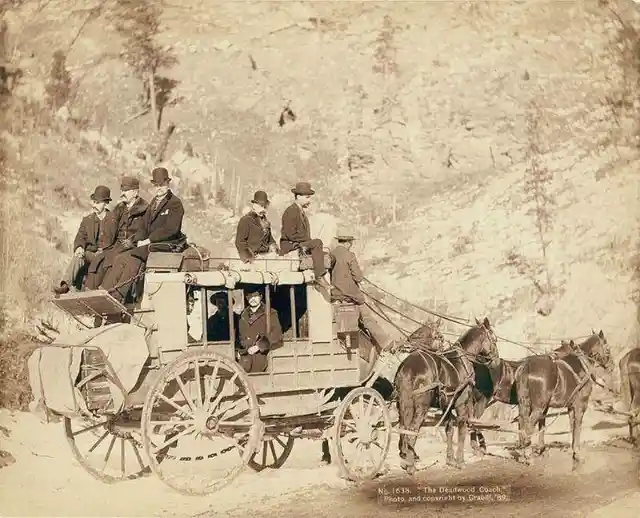

The photo of this specific stagecoach transported Buffalo Bill in all his Wild West shows throughout the US and Europe. How many adventures would this coach have seen?
Annie Oakley
Annie Oakley (born Phoebe Ann Mosey), is one of the most well-known faces of the Wild West after becoming famous for her exceptional sharpshooting skills when she was just 15 years old. By age eight, in order to support her family following the death of her father, Oakley had started learning to trap, shoot, and hunt.
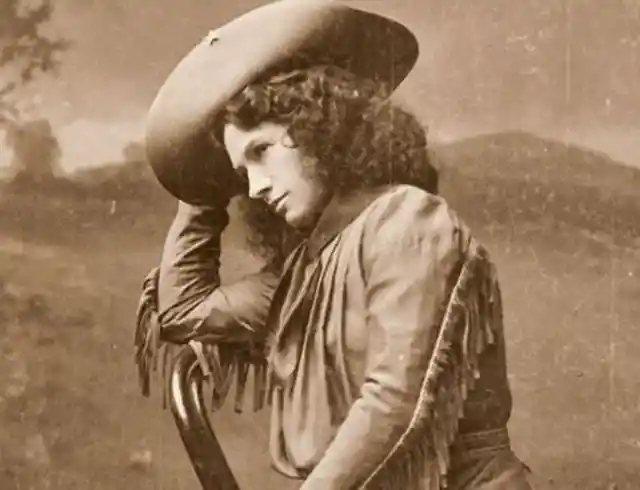
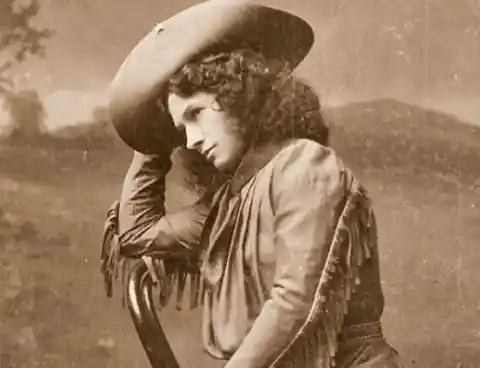
Oakley later married Frank E. Butler, a fellow marksman and former rival. After making a name for herself as a trained shooter, Oakley and her husband joined Buffalo Bill's Wild West Show. As a result, she soon became a worldwide star.
Cowgirls Congregating At A Watering Hole
Cowgirls weren't just cute little women dressed up in boots and fringes. They actually held shotguns, rode broncos and even performed at times. Some of the more famous cowgirls of the era were Annie Oakley, Calamity Jane, and Dale Evans.


Cowgirls and rodeo cowgirls (sometimes called rodeo queens) were a huge feature of the Wild West. They were brave, fun-loving, hard-working, and maybe just a little bit crazy.
The Palisades
American photographer Alfred A. Hart was is the only photographer to have been named official photographer of the western half of the transcontinental railroad in the 1860s. It is an impressive title.

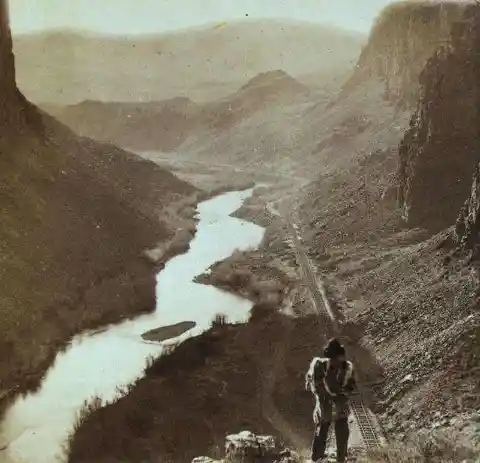
The picture above displays the Palisade Canyon, also called the 10-Mile Canyon or the 12-Mile Canyon in 1868. The Palisades are located in the northeastern section of the state of Nevada in Eureka County in the western United States. It is about 10 miles southwest of Elko.
Wagon Trail
Renown photographer Timothy O’Sullivan owned the darkroom wagon pictured above. All of the photos we have seen here from O'Sullivan are believed to have been developed in this specific wagon. The footprints visible in this photo shows exactly where O'Sullivan walked to take the picture.
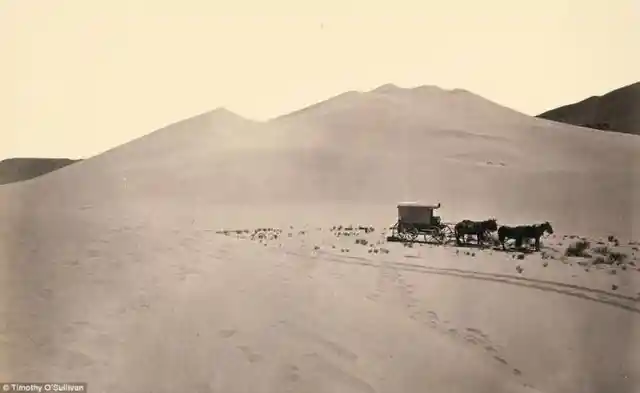

The photograph was taken in Carson Sink, Nevada, where the sand dunes can stretch for miles and miles at a time.
Colorado River’s Black Canyon
One of the most famous landmarks of both Nevada and Arizona's landscape happens to be Colorado's Black Canyon. Visible in the photo above is a part of the Colorado River where decades later the Hoover Dam would be built.


Surrounded by the El Dorado Mountains and Arizona's Black Mountains, the Black Canyon contains hot springs which make for some gorgeous landscape photography.
Big Cottonwood Canyon, Utah
A fantastic place to go fishing even today, Big Cottonwood Canyon in Salt Lake City, Utah was a popular fishing spot as far back as the 19th century. It still remains a popular destination for hiking, rock-climbing, and camping.


The canyon contains several species of fauna and flora being one of the most biologically diverse places in all of the United States.
Outlaw: Johnny Ringo
The original Ringo? Johnny Ringo, was one of the most infamous members of a notorious group of outlaws called the Cochise County Cowboys. This group terrorized the town of Tombstone, Arizona for a while. It's now becoming clearer how this town got its name.


Ringo was one of the men who tussled in a shootout with Wyatt Earp and Doc Holliday who has we know had a thing for gunfights.
Villa Of Brulé
How many teepees can you count? Captured in this photo is the Villa of Brulé near Pine Ridge in present-day South Dakota. Also in this picture is a large Native American camp which lies on the edge of the villa. This photo was taken by John C.H. Grabill.


The photograph, shot in 1891, includes a hostile looking Lakota teepee camp at the back and White Clay Creek near the front.
Chinese Railroad Workers
Despite being underappreciated and overworked, Chinese railroad workers were crucial in the construction of the Transcontinental Railroad who experienced a somewhat complicated history in the founding of the West. Without them, the famous railroad might have never been built at all.


In spite of blatant discrimination from companies who refused to provide Chinese workers with housing or board, Chinese workers stuck it out. They were usually overloaded yet were paid significantly less than their Caucasian counterparts. Even though there were financial and labor issues, the railroad was eventually completed.
Browns Park, Colorado
Browns Park as it is known today, or Brown's Hole as it was first called, is an isolated mountain valley which encompasses Flaming Gorge Dam and ends at the Gates of Lodore in Dinosaur National Monument.


Browns Park played haven to infamous outlaws such as Butch Cassidy and Tom Horn in the late 19th century. It was also the place where Ann Basset, an associate of Cassidy's Wild Bunch gang, was born.
Gold Hill, Nevada
Located south of Virginia City in Nevada City, Gold Hill became famous for mining the Comstock Lode. At one point it was a highly prosperous town, but over the years the population has dwindled down to around 191 inhabitants.

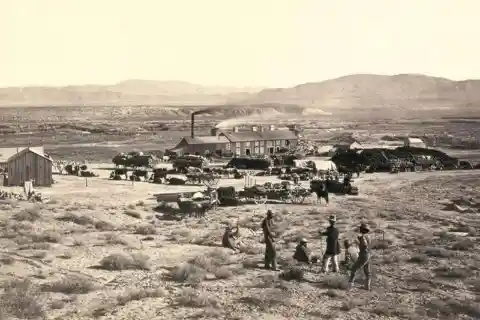
There still exist some historical remnants such as Gold Hill Hotel, which is promoted as Nevada's oldest hotel and has been in existence since 1861; the former Bank of California building; a restored railroad depot; a Depression-era mill, and remains of mines and residences.
Pyramid Lake, Nevada
A geographic sink of the Truckee River Basin in Reno, Nevada, the peculiarly named Pyramid Lake starkly contrasts with that of neighboring clear Lake Tahoe. The lake is incredibly salty as its salinity is approximately 1/6 that of seawater as the only way for water to leave the lake is through evaporation.


Several large battles of the Paiute War were fought in this area which might have been because the area surprisingly houses an abundance of fish.
Timothy O’Sullivan, Photographer
A face to put to the name! We've dug through several of Timothy O'Sullivan's photographs pictured above is a photo of O'Sullivan himself. O'Sullivan decided to become a photographer following his tenure as a soldier in the Civil War. His aim was to document and share with the world the horrors of war.


After the war ended, he decided to explore the Western landscape of America and journeyed on a lengthy cross-continental expedition traveling with a surveying team. This is why we are able to see so much of his work.
Whirling Horse
The splendidly named Whirling Horse was another Native American who performed in Buffalo Bill's Wild West Show. As a member of the show, he partook in reenacting historical battles and also perform native dances for audiences.


Ahead of its time, the Native Americans of the group would additionally perform shows illustrating aspects of their culture which evidently included them portraying themselves as victims of western expansion who were forcibly removed from their ancestral homelands.
The show is credited with helping ease tension and public opinion between the two sides near the end of the White-Native American Wars after years of US propaganda against the natives. After performing in the Wild West Shows, several of these Native Americans became silent film stars, playing similar roles.
Canyon De Chelly, Arizona
Timothy O’Sullivan as we previously stated, was one of the most well-known photographers of the 19th century. He wasis widely known for his body of work during the American Civil War, as well as for his photography of the Western United States.


Seen in this picture is the Canyon de Chelly in Arizona. The canyon is one of America's national monuments and sits on the boundary of the Navajo Nation. At one time, the canyons housed the Pueblo people.
The Bath House
A place of legend to Native American tribes, Hot Springs in Arizona now sells itself as a relaxing weekend getaway. In the past, it was known for its supposed medicinal properties. A visit to the springs was accompanied with hope for curing any ailment.


Nowadays, it not only serves as a popular visitor attraction but also holds the oldest federal reserve anywhere in the United States.
Shoshone Falls, Idaho
Timothy O’Sullivan sure had an eye for picturesque photographs. This picture captures the raw beauty of Shoshone Falls, more specifically the falls located in Snake River, Idaho. A little-known fact about these mighty falls is that it is taller than Niagara Falls! Perhaps this is why they sometimes call it the “Niagara of the West”.


Right through the 19th century, the area acted as an integral fishing and trading place for Native Americans. Today, it serves primarily as a tourist destination.
Apache Spirit Dancers
Apache tradition holds the view their ancestors lived side by side with supernatural beings! These gods among us are said to be residing in underground realms as well as the surrounding mountains. The Apache spirit dancers pictured here are believed to have the ability to summon the spirit of these powerful beings and act as a link between the supernatural and natural worlds.


The Apache happens to include several Native American tribes who originated in the Southwestern United States continent. The Apache adapted to their surroundings and learned to live off the land as they relied on scarce food and learned to survive harsh climatic conditions.
More Than A Picture Was Shot
It might be hard to believe but the subject of this photo is "posing" after being shot to death by a five-man posse on the orders of Sheriff Charles A. Shibell in 1878. The masked man is William Whitney Brazelton, also known as Bill Brazen.

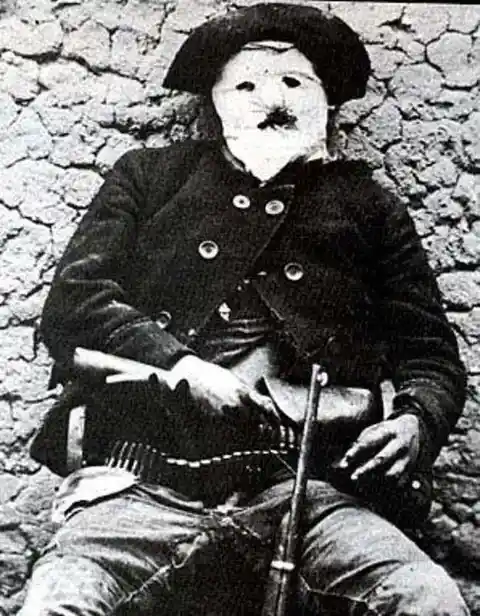
Not much is known about Brazen, who was known as a stage robber and an outlaw during the second half of the 1800s. It is said he was San Francisco native and claimed his first victim at only age 15.
You Booze You Lose
Respectable women had a tough time finding themselves some liquor in the old west. Why? Well, women weren't welcome in saloons back then. Until World War I women were barred from entry in most saloons unless of course, they were saloon girls, prostitutes or dancers - oh, how convenient!


Some saloons did cater to women but only in secret. By 1893, the same respectable women who were denied service founded the Anti-Saloon league which became the most powerful prohibition lobby in America. Hell hath no fury like a woman scorned.
Olive Oatman
One day while the Oatman family were traveling through what is today Arizona, Olive and her sister were kidnapped and sold to the Mohave people. The rest of Olive's family were attacked and killed by a group of Native Americans. Her sister died in captivity of starvation.


Easily recognized by her blue chin tattoo, Olive thought it was a sign of slavery among the Mohave tribe where she was held. However, this contradicts tribal traditions. According to the Mohave people, every member of a tribe receives face tattoos. Despite Olive's story being widely publicized, few details are known about her time with the Mohave tribe.
Fortune Tellers
In the wild west fortune-telling was a popular pastime. It was mainly associated with Gypsies or Romani people. The largest wave of Romani immigration to North America began in the late 19th century, however, Romani slaves were shipped to America as far back as 1492.


Some of the ways Romani used to tell the future were through Tarot card reading, palm reading and crystallomancy (where a crystal sphere was used to predict a person's future). Later, there were even automated fortune telling machines, some of which can still be found even today.
Outlaw: Jesse James
Jesse James wasn't just one of America's most notorious outlaws. His other talents (if you can call them that) included being a gang leader, a bank and train robber, a guerrilla fighter, and of course, a murderer. James, born in Missouri, and his brother formed the James-Younger Gang. Talk about brothers in arms.


The two started as Confederate bushwhackers during the American Civil War but were later accused of committing multiple monstrosities against Union soldiers during the war, which included their many now infamous robberies.
Jackpot Poker
Gambling was one of the most popular forms of entertainment in the old west. Most times this took place in saloons. Poker was popular with many, as well as three-card monte, Faro and several types of dice games. Billiards and bowling were later also introduced.

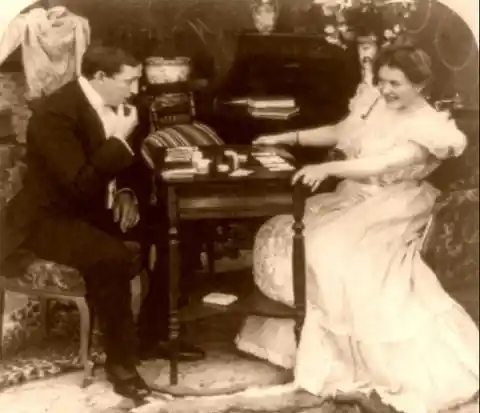
James Hildreth's 1836 book “Dragoon Campaigns to the Rocky Mountains” was the first to document Poker which was developed in the United States. However, gaming historians suggest the source of the game is either a French game named Poque or the Persian game of As-Nas.
Outlaw: Pearl Hart
Pearl Hart, infamous for her stagecoach robberies and an escape from prison, she went onto reach a level of celebrity in her time. Subsequently getting nabbed after to a stagecoach robbery in Arizona, Hart was astoundingly locked up in an all-male prison. Being quick-witted, she used the situation to her advantage, particularly the admiring guards.


Unlike other outlaws, Hart turned to a life of crime to earn money for her ill mother, having been well-educated since she was raised in a rather wealthy family. Hart would regrettably elope, later giving birth to two children. She eventually left her husband for good and moved to Phoenix due to his physical abuse.
Hiding In Plain Sight
Brothels despite being officially illegal in the wild west were quite common and normally lay in plain view. Some madams were even considered respectable citizens since they donated much of their profits to society. The fact remained, however, that the majority of them were young and illiterate.


Fellas could get awfully lonely after spending days at a time inside a mine. This is when these scarlet women came along to offer "comfort" and "companionship" to these poor tired old miners. If business turned out to be booming so to speak, an entire red light district would soon rise up.
Queen Of The Red Light District
Josephine "Chicago Joe" Airey was a famous prostitute and business owner. Hailing from Helena, Montana, apart from being a madam, Airey also owned brothels, saloons, dance halls, a theater and quite a bit of land it seems. After several successful ventures, Airey happened to be the most influential landowner in her town.
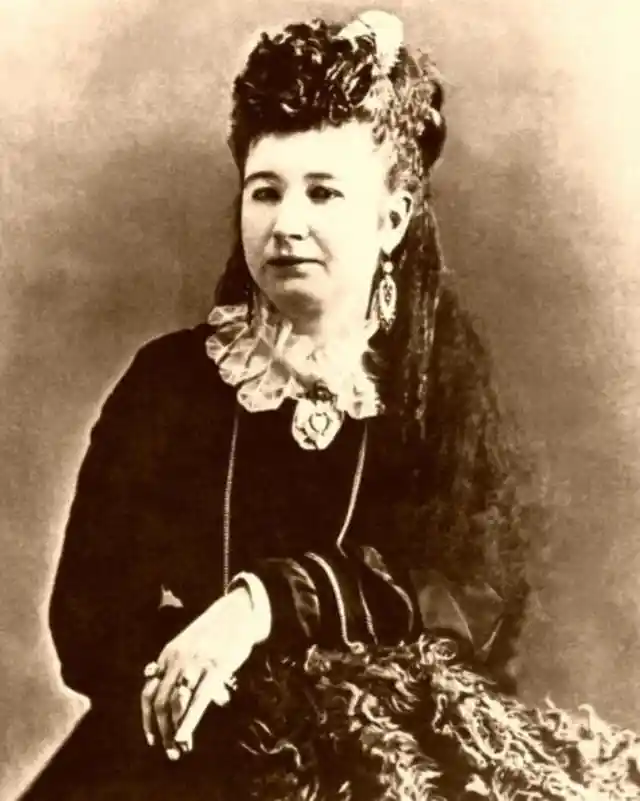

Popular for their lavish parties, Airey, and her spouse were famous among the citizens of Helena. Humorously, in 1883 Airey had a notice printed in the local newspaper demanding saloons and gambling houses in the area not to permit her husband entry. Clearly, they didn't mind airing their dirty laundry.
Ox Teams At Sturgis
The photo above is located in the United States Library of Congress and comes from the largest surviving collection of John C.H. Grabill's portfolio of work. This picture shows offers a glimpse of frontier life in Sturgis, South Dakota.


Who rides a car when they've got a wagon? That's what it must have been like for those in the Dakota Territory which consisted of hunters, prospectors, and cowboys, many of whom used teams of oxen to move around.
Rotgut
Liquor in the old west was as popular as ever, but it sure wasn't cheap. Saloon owners began to generate more bang for their buck by diluting their good liquor with other ingredients. These included turpentine, ammonia, gunpowder, or cayenne!


Some of these mixes had rather curious names such as Tanglefoot, Forty-Rod, Tarantula Juice, Taos Lightning, Red Eye, and Coffin Varnish.
Other types of liquor drunk by patrons were Allston cocktail (made with gin, lemon juice, and peppermint schnapps), and a timeless mix of brandy and soda called B&S. Wine and champagne were also favorites among the patrons.
Bullet Dance With Me
What in tarnation? This photo looks like a scene from an old west movie. One poor soul is attempting to avoid getting shot in the leg by jumping as fast as possible while the rest of the jolly group shoot at his feet. In the old west, this was known as a "bullet dance".


Even the bartender seems to be joining in the fun as he points the gun at the unfortunate man's head. Talk about service with a smile. This photo is believed to have been captured in Wyoming. Not everyone was a fan of saloons it seems.
Outlaws: Rufus Buck Gang
Baby-faced killers? This ragged looking bunch were known as the Rufus Buck Gang, formed and headed by Rufus Buck. This multi-racial band of hoodlums robbed both stores and ranches around the Arkansas-Oklahoma areas in the late 1800s.


After committing a number of heinous crimes, such as killing several men including U.S. Deputy Marshal John Garrett, the group ran out of luck and were captured outside Muskogee, Oklahoma. They received a death sentence soon after and were hanged in 1896.
Maggie From Bowery
"Maggie: A Girl of the Streets" written by Stephen Crane in 1893 was considered a rather risqué novella in its time. This was because the story revolved around a poor young girl from Bowery whose life ends in misery after a shocking twist. Crane later wrote a sequel called "George's Mother".


In the original novel, Maggie and her brother are raised in poverty by drunk and violent parents. Despite her attempts to improve her life, Maggie's mother's drunken rages put to be her efforts. Poor Maggie, after being seduced by her brother's friend, gets rejected by her family before becoming a prostitute and dying shortly after.
Gambling Hall Poker Game
Gambling was a central part of life in the wild west, particularly in the 19th century. Some of the first buildings to actually be constructed were gambling halls! Men turned up to these places in search of one or more of the 3 naughty W's: wagering, whoring, or and/or whiskey drinking.


Many at the time considered gambling to be a profession, further increasing its popularity. Of course, this also led to its own share of trouble for those on the wrong side of the table! Boys will always be boys as they say.
Santiago ‘Jimmy’ McKinn
One day Santiago "Jimmy" McKinn, then aged 11 or 12, went out with his brother Martin when a group of Chiricahua Apache led by the legendary Geronimo approached the two near his family's home in the Lower Mimbres Valley in New Mexico. The Apache then proceeded to kill young Martin and abducted Santiago!


Fortunately for Santiago, he was later rescued by General George Crook, but for some reason, the boy didn't want to go back to his family and instead wanted to stay with the Apache. His family would have none of it, however, and he was soon returned.
The photo shows Santiago next to his newfound friends with whom he lived for six months. In this time he learned both their language and lifestyle.
Rose Dunn
Rose Dunn, known as Rose of the Cimarron, shared a romance with the outlaw George "Bittercreek" Newcomb when she was about 14 or 15. The outlaw's gang apparently adored Dunn for her classy demeanor and good looks. After a shootout with U.S. Marshalls, the gang was forced into hiding.

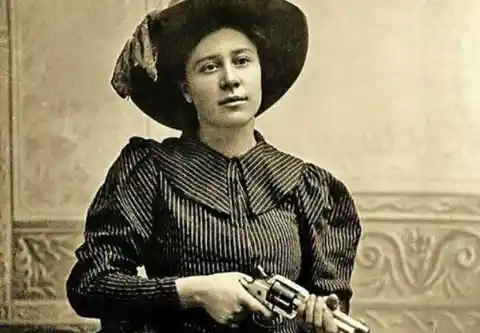
When Newcomb and another member went back to visit Rose, her brothers shot them on site! Now that's a cowboy welcome for you! The Dunn's then collected a $5,000 "Dead or Alive" bounty for Newcomb. It is rumored Dunn set her lover up, but the truth remains shrouded in mystery.
The Customer Is Always Right?
Like bread and butter, outlaws and brothels always were a natural match. Fannie Porter must have had this on her mind since she was known for never turning in her customers, yes, even criminals. She was respected among criminals for her warm demeanor and sincere attitude but mainly for her discretion.


Respected by the Wild Bunch, this ex-prostitute housed frequent clients such as Butch Cassidy, the Sundance Kidd, Kidd Curry, and other members of the gang. Talk about an outlaw hall of fame! Some of her San Antonio brothel's "girls" became involved with some gang members. Pictured above is Laura Bullion of the Wild Bunch who is thought to have worked in the brothel for a while.
Gun-Toting Women
There were many male gunslingers aplenty as we've discussed, but there were also a number of notable female gunslingers and outlaws in the wild west. Doc Holliday's wife, "Big Nose Kate", for example, is said to have aided his escape from jail by setting it on fire!


Another well-known gun-toting western figure was Calamity Jane. She worked as a part-time prostitute, wore men's clothes, and even performed in wild west shows! There were also the skillful shooter Pearl Hart, teenage sharpshooter Lillian Smith, and Mary "Stagecoach Mary" Fields who was an emancipated slave always ready to fight.
Women In The Gold Rush
The California Gold Rush began in 1848 and attracted people the world over to its gold mines. At first, the increasing populace had few women, which created plenty of opportunities for women in the vicinity to take advantage of the situation. Later this attracted more women to move to California.


Some women took part in the search for gold, working together with their husbands and families. Other women would come all on their own in search of wealth. Apart from gold panning, other occupations these women took up were housekeeping, cooking, washing clothes, acting, and dancing.
Members Of Buffalo Bill’s Troupe
Buffalo Bill's Wild West Show featured people from all walks of life. Gathered around a log cabin in this photo were members of the show. The troupe even traveled through the country, later taking their talents to Europe and the world.


This photo includes a group of men including a Sioux Native American, John Nelson, John Burke, and other stern looking cowboys.
War Hero Charley Nebo
Charley Nebo, who is wearing his hat in this photo, was born in 1842 to a Canadian mother and an English father. He lived in New Mexico, Texas, and Nebraska during his life and was a famous cowboy in his day.


Nebo was honorably discharged from the Union army following the Civil War. During his service, he suffered a painful injury which left him permanently handicapped.
Nebo later became a stockman and afterward worked for John Chisum's cattle empire in 1878. He was famously good friends with the infamous robber, Billie The Kid, and was also known as a skilled cowboy himself.
Bottoms Up
It could get mighty hot traveling through on horseback and cowboys like anyone else liked to drink. In this photo, we see a group of cowboys enjoying a drink while speaking with the bartender at a saloon in Old Tasacosa, Northern Texas in 1907.


Saloons were a one-stop entertainment area for men as it was not only a place to have a drink, but also a place to rest, play poker, or negotiate cattle. Some saloons were even open 24/7 and popular with gold diggers, soldiers, lawyers, and travelers apart from cowboys.
Texas Jack
John "Texas Jack" Wilson Vermillion was worked with the Earp brothers in their vendetta rides seeking out outlawed cowboys. A legendary gunfighter by reputation, he was also known as "Shoot-Your-Eye-Out Vermillion" as he supposedly once shot a man in the eye. Ouch.


His nickname, Texas Jack is reportedly due to him having been listed like that in his wanted posters after he shot a man during an argument at cards. Once asked why he was called by Texas Jack, he remarked, “Because I’m from Virginia.” Who are we to question a cowboy, huh.